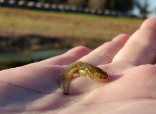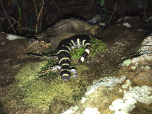Ringed Salamander (Ambystoma annulatum)
Description: The Ringed Salamander has a slender body shape with a small head and a long tail. This species has 15 costal (along the ribs) grooves and a depressed round snout. There are two arrays of vomerine teeth—teeth along a thin bone that form the inferior and posterior part of the nasal septum and divide the nostrils. Each series contains 7 to 11 teeth. Each of their hind feet has five toes. The dorsal color of adults can range from dark gray to blackish brown decorated with white to yellowish bands and light-colored dots. Ventral sides are generally grayish-yellow. Newly metamorphosed juveniles have black backs and white bellies. A row of light spots extended from their forelimbs to the tails. Soon after metamorphosis yellow bands started to appear, and complete adult colorations form within two months after metamorphosis.
Habitat: Ringed salamander is strictly terrestrial and has been found in hardwood and mixed hardwood-pine forests. During non-breeding seasons, adults hide under leaves, rotting logs, or abandoned holes on the ground in damp forest areas. Larvae and juveniles exist in small, fishless semi-permanent ponds.
Range: Most ringed salamanders are found in the vicinity of Hot Springs, Arkansas, and the Missouri portion of the Ozark Plateau. Small populations have also been found in western Illinois and eastern Oklahoma.
Found in these States:
KS |
MO |
OK
Diet: Common preys for ringed salamander larvae include microcrustaceans, dipteran larvae, larval chironimids, and many larval and adult insects such as beetles, snails, earthworms, and eggs of other salamanders and frogs. Ringed salamanders usually serve as the top predator in their breeding ponds. This is likely due to the fall breeding timing of ringed salamanders, which allows them to prey on individuals of other spring breeding species that are still in their early life stages such as spotted salamanders, marbled salamanders, red-spotted newts, and many other anuran species, thus decreases their abundances.
Reproduction: Eggs are fertilized internally via spermatophores and the eggs are deposited in shallow, fishless water in the fall, mostly in October. Courtship occurs in shallow water as well.
They reproduce at night in breeding ponds where hundreds of them congregate. Usually the males are found at the breeding ponds first, and are distinguishable from the females by their swollen cloacas. Males will usually approach females. They start off by nudging the female's cloaca, and then swim off a short distance and deposit a few spermatophores. A male may deposit nine spermataphores in two minutes. The more males that come into the breeding area, the less specific males get when depositing spermatophores, nudging both males and females before deposition. Males deposit spermatophores on rocks, on other spermatophores, and even on other individuals. At this time females are generally passive and do not pick up seminal fluid while they are actively being courted by males. Breeding lasts a few days, after which the salamanders begin to move away from the pond.
Ringed salamanders reproduce in shallow water. Breeding takes place in the fall between September and November. Cool temperatures and heavy rains stimulate breeding. Females begin ovipositing within 1 to 2 days after breeding. These salamanders are usually sexually mature 2 to 3 years after metamorphosis. Eggs are laid in clusters with an average of 10 eggs in a cluster. Usually, about 150 eggs are laid in total and are sometimes attached to vegetation but are usually laid directly on the bottom of ponds. The embryonic period of A. annulatum is fairly short. Premature pond freezing and drying are the biggest risks to the embryos and larvae. A. annulatum is an explosive breeder, and at times breeding males will try to reproduce 2 to 4 times during the breeding season.
Status: Listed as Least Concern in view of its wide distribution and presumed large population.
»» Kingdom: Animalia - Animals
»» Phylum: Chordata - Chordates
»» Subphylum: Vertebrata - Vertebrates
»» Class: Amphibia - (Amphibians)
»» Order: Caudata - Salamanders
»» Family: Salamandridae - Newts
»» Subfamily: Pleurodelinae - Pleurodeline Newts
»» Genus: Ambystoma
»» Species: Ambystoma annulatum - Ringed Salamander
This article uses material from the Wikipedia article "Ringed Salamander", which is released under the Creative Commons Attribution-Share-Alike License 3.0. Content may have been omitted from the original, but no content has been changed or extended.
|













